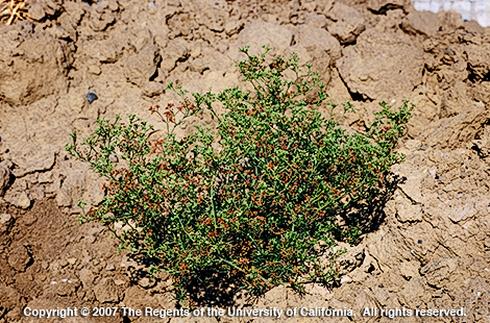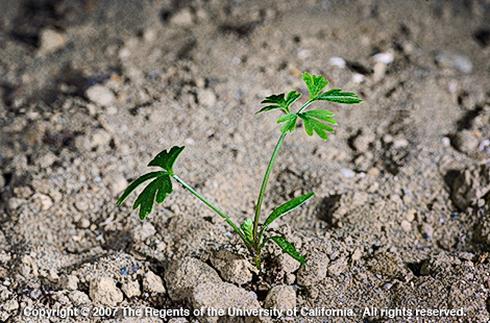Wild celery is a winter or summer annual broadleaf plant. It is scattered throughout California to about 500 feet (150 m).
Habitat
Wild celery is found in vegetable crops, orchards, fields, associated with field edges and ditches, gardens, turf and landscaped areas, and other disturbed places such as railroad tracks, roadsides.

Seedling
Cotyledons (seed leaves) are hairless and linear and about 1/6 to 2/5 inch (4â??10 mm) long and 1/25 inch (1 mm) wide. The first leaf is deeply lobed (3 lobes) with a long stalk.

Mature Plant
The mature plant forms an erect to decumbent (prostrate stems with erect tips) mound and can grow to 2 feet (0.6 m) in length. However, Â it will adapt to mowing. Like the seedling it is hairless. Its leaves alternate along the stem and are deeply dissected into threadlike segments. The entire leaf ranges from 1-1/5 to 4 inches (3â??10 cm) long and the leaf segments, from about 1/8 to 3/5 inch (0.3â??1.5 cm). Upper leaves are stalkless and more threadlike and lower leaves have stalks ranging from roughly 4/5 to 5 inches (2â??12 cm).
Flowers
Flowers bloom from April though August. Individual white, minute, five-petaled flowers bundle to form clusters (inflorescence) called umbels. The umbles have a flat-topped umbrella shape.. Some wild celery umbels are simple umbels, because the individual flower stalks radiate from a common point, forming an umbrella “shape”. Others are compound umbels, which form when several simple umbels cluster on a stalk. In wild celery, under each umbel are 1 to 3 rays or threadlike green bracts, less than 4/5 inch (2 cm) long.

Fruits
Fruit are oblong to egg shaped, slightly flattened, hairless, and 1/25 to 1/8 inch (1â??3 mm) long. They have about 5 thick, angled ribs.

Reproduction
Wild celery reproduces by seed. Seeds disperse with water, soil, equipment, and other human activities and possibly as a contaminant in seed or feed.

Related or Similar Plants
- Greater ammi, Ammi majus
- Poison hemlock, Conium maculatum
- Toothpick ammi, Ammi visnaga
- Wild carrot, Daucus carota
